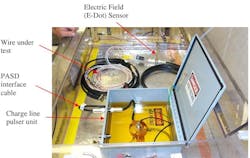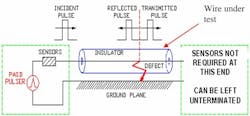A little short circuit can lead to big trouble. In 1996, a spark caused by faulty wiring insulation exploded fumes inside TWA Flight 800's fuel tank, leading to a horrific explosion and crash that caused the deaths of 230 people.
With lives and property on the line, finding and fixing intermittent short circuits—and the dangerous sparks and heat they can generate—is a top priority for organizations ranging from vehicle manufacturers to insurance companies to the military. Yet pinpointing intermittent circuit faults is often a cumbersome and time consuming process, especially when wiring harnesses are crammed behind walls and bulkheads.
Researchers at Sandia National Laboratories in Albuquerque, N.M., who began examining the problem of sparking wires several years ago, now believe they have found a fast and foolproof way of sniffing out and fixing hazardous wiring tucked deep inside vehicles and buildings. The researchers' idea is to fight fire with fire by using controlled sparks to locate faulty wires that may soon create their own random sparks.
The Pulse Arrested Spark Discharge (PASD) system is a suitcase-sized test unit that can be plugged into vehicle wiring harnesses, 40 wires at a time, to check for the nearly invisible insulation breaks that can cause intermittent short circuits (see photo). "Instead of reacting to a problem, we can discover a fault before it creates a catastrophic event," says Larry Schneider, the research team's leader and deputy director of Sandia's Pulsed Power Sciences Center.
PASD works by forcing a faulty wire to expose itself in a controlled environment rather than while in routine operation. The device sends a high-voltage, nanosecond-long electrical pulse through the circuit. The short pulse is driven so strongly that it can jump between gaps in slightly frayed insulation, yet it's weak enough to cause no damage. "It's like sending a trickle of water over a high waterfall," says Schneider. The generated spark jumps from the defective wire to a nearby ground or another damaged wire. The amount of time it takes for the current to return to its source is analyzed by the system's automated test-set, which can tell users how far the break is from the test entry point.
The technology eliminates the need to tear into complex harnesses to search out defective wiring that may appear undamaged to the naked eye. "The missing insulation may only be a pinhole or a fine cut, nearly impossible to detect visually," says Schneider. "PASD works like a tracer bullet to light up the wire's damage point."
PASD's first commercial application will be to find faulty wiring inside aircraft. Astronics Advanced Electronic Systems of Redmond, Wash., has licensed the technology from Sandia and plans to use it in a new line of test gear. Possible future applications include testing the wiring inside passenger vehicles and new homes, as well as in submarines, tanks and other types of military equipment. "We've actually turned electrostatic discharges into a force for good," says Schneider.
Pulsed Power Sciences Center; Sandia National Laboratories
www.sandia.gov
[editor note 6/26/25: the following attachment was not available at the time this article was originally published. It has much more detail on how the PASD system works, as well as presenting results of measurements by the system. Courtesy Sandia National Labs. enjoy...andyT]


